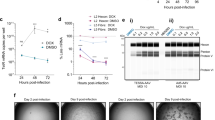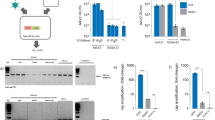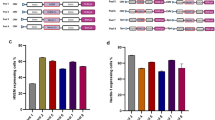Abstract
Recombinant adeno-associated virus (rAAV) vectors are under consideration for a wide variety of gene therapy applications. One of the limitations of the rAAV vector system has been the difficulty in producing the vector in sufficient quantity for adequate preclinical and clinical evaluation. A common method for vector production involves large-scale transient transfection of multiple plasmids into cultured cells. Because this approach might not be feasible for clinical scale manufacturing, we have sought approaches for rAAV vector production that avoid transient transfection procedures. In previously reported work, we generated an AAV packaging cell line that produces infec- tious rAAV when the vector genome is transfected into the cell line as plasmid DNA. We have now extended this approach by constructing a hybrid recombinant adenovirus (rAd) that contains a complete rAAV vector genome in the E1 region. This hybrid virus is used to deliver the rAAV genome to the packaging cell line (in the place of plasmid transfection). rAAV is produced when the packaging cell line is infected with the hybrid adenovirus and wild-type adenovirus. This method avoids the need for plasmid transfection and is adaptable to large-scale manufacturing processes.
This is a preview of subscription content, access via your institution
Access options
Subscribe to this journal
Receive 12 print issues and online access
$259.00 per year
only $21.58 per issue
Buy this article
- Purchase on Springer Link
- Instant access to full article PDF
Prices may be subject to local taxes which are calculated during checkout







Similar content being viewed by others
References
Clark KR, Sferra TJ, Johnson PR . Recombinant adeno-associated virus vectors mediate long-term transgene expression in muscle Hum Gene Ther 1997 8: 659–669
Flannery JG et al. Efficient photoreceptor-targeted gene expression in vivo by recombinant adeno-associated virus Proc Natl Acad Sci USA 1997 94: 6916–6921
Flotte TR et al. Stable in vivo expression of the cystic fibrosis transmembrane conductance regulator with an adeno-associated virus vector Proc Natl Acad Sci USA 1993 90: 10613–10617
Xiao X, Li J, Samulski RJ . Efficient long-term gene transfer into muscle tissue of immunocompetent mice by adeno-associated virus vector J Virol 1996 70: 8098–8108
Fisher KJ et al. Recombinant adeno-associated virus for muscle directed gene therapy Nature Med 1997 3: 306–312
Koeberl DD et al. Persistent expression of human clotting factor IX from mouse liver after intravenous injection of adeno-associated virus vectors Proc Natl Acad Sci USA 1997 94: 1426–1431
Kaplitt MG et al. Long-term gene expression and phenotypic correction using adeno-associated virus vectors in the mammalian brain Nat Genet 1994 8: 148–154
Kessler PD et al. Gene delivery to skeletal muscle results in sustained expression and systemic delivery of a therapeutic protein Proc Natl Acad Sci USA 1996 93: 14082–14087
Snyder RO et al. Persistent and therapeutic concentrations of human factor IX in mice after hepatic gene transfer of recombinant AAV vectors Nat Genet 1997 16: 270–276
Xiao X, Li J, Samulski RJ . Production of high-titer recombinant adeno-associated virus vectors in the absence of helper adenovirus J Virol 1998 72: 2224–2232
Atchison RW, Casto BC, Hammon WM . Adenovirus-associate defective virus particles Science 1965 149: 754–756
Hoggan MD, Blacklow NR, Rowe WP . Studies of small DNA viruses found in various adenovirus preparations: physical, biological and immunological characteristics Proc Natl Acad Sci USA 1966 55: 1457–1471
Buller RM, Janik JE, Sebring ED, Rose JA . Herpes simplex virus types 1 and 2 completely help adenovirus-associated virus replication J Virol 1981 40: 241–247
McPherson RA, Rosenthal LJ, Rose JA . Human cytomegalovirus completely helps adeno-associated virus replication Virology 1985 147: 217–222
Allen JM, Debelak DJ, Reynolds TC, Miller AD . Identification and elimination of replication-competent adeno-associated virus (AAV) that arise by nonhomologous recombination during AAV vector production J Virol 1997 71: 6816–6822
Salvetti A et al. Factors influencing recombinant adeno-associated virus production Hum Gene Ther 1998 9: 695–706
Clark KR, Voulgaropoulou F, Johnson PR . A stable cell line carrying adenovirus inducible rep and cap genes allows for infectivity titration of adeno-associated virus vectors Gene Therapy 1996 3: 1124–1132
Clark KR, Voulgaropoulou F, Fraley DM, Johnson PR . Cell line for the production of recombinant adeno-associated virus Hum Gene Ther 1995 6: 1329–1341
Vincent KA, Piraino ST, Wadsworth SC . Analysis of recombinant adeno-associated virus packaging and requirements for rep and cap gene products J Virol 1997 71: 1897–1905
Li J, Samulski RJ, Xiao X . Role for highly regulated rep gene expression in adeno-associated virus vector production J Virol 1997 71: 5236–5243
Wang XS, Srivastava A . A novel terminal resolution-like site in the adeno-associated type 2 genome J Virol 1997 71: 1140–1146
Wistuba A et al. Subcellular compartmentalization of adeno-associated virus type 2 assembly J Virol 1997 71: 1341–1352
Weger S, Wistuba A, Grimm D, Kleinschmidt JA . Control of adeno-associated virus type 2 cap gene expression: relative influence of helper virus, terminal repeats and Rep proteins J Virol 1997 71: 8437–8447
Jones N, Shenk T . An adenovirus type 5 early gene function regulates expression of other early viral genes Proc Natl Acad Sci USA 1979 76: 3665–3669
Pereira DJ, McCarty DM, Muzyczka N . The adeno-associated virus (AAV) Rep protein acts as both a repressor and an activator to regulate AAV transcription during a productive infection J Virol 1997 71: 1079–1088
Thrasher AJ et al. Generation of recombinant adeno-associated virus (rAAV) from an adenoviral vector and functional reconstitution of the NADPH-oxidase Gene Therapy 1995 2: 481–485
Fisher KJ, Kelly WM, Burda JF, Wilson JM . A novel adenovirus adeno-associated virus hybrid vector that displays efficient rescue and delivery of the AAV genome Hum Gene Ther 1996 7: 2079–2087
Author information
Authors and Affiliations
Rights and permissions
About this article
Cite this article
Liu, X., Clark, K. & Johnson, P. Production of recombinant adeno-associated virus vectors using a packaging cell line and a hybrid recombinant adenovirus. Gene Ther 6, 293–299 (1999). https://doi.org/10.1038/sj.gt.3300807
Received:
Accepted:
Published:
Issue Date:
DOI: https://doi.org/10.1038/sj.gt.3300807
Keywords
This article is cited by
-
Self-attenuating adenovirus enables production of recombinant adeno-associated virus for high manufacturing yield without contamination
Nature Communications (2022)
-
Transient receptor potential melastatin 8 ion channel in macrophages modulates colitis through a balance-shift in TNF-alpha and interleukin-10 production
Mucosal Immunology (2016)
-
Scalable manufacturing methodologies for improving adeno-associated virus-based pharmaprojects
Chinese Science Bulletin (2014)
-
Intron Splicing–mediated Expression of AAV Rep and Cap Genes and Production of AAV Vectors in Insect Cells
Molecular Therapy (2008)
-
Toward exascale production of recombinant adeno-associated virus for gene transfer applications
Gene Therapy (2008)



